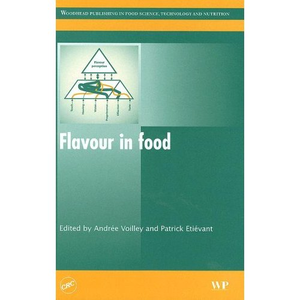Genetic influences on taste
Prescott, J. (2006) Genetic influences on taste. In: Voilley, Andrée, and Etiévant, Patrick, (eds.) Flavour in Food. Woodhead Publishing, Cambridge, UK, pp. 308-326.
|
PDF (Published Version)
Restricted to Repository staff only |
||
![[img]](https://researchonline.jcu.edu.au/3634/2.hassmallThumbnailVersion/3634_Prescott_2006.jpeg)
|
Image (JPEG) (Cover Image)
Download (31kB) |
Abstract
[Extract] As consumers, our sensory and hedonic experiences of foods and beverages are most often of an overall flavour percept that depends upon the integration of multiple, distinct sensory qualities - in particular, olfactory and taste qualities (Prescott 2004). In contrast to the rich, perhaps limitless, inventory of odours that contribute to flavours, however, the sense of taste may consist of no more than a handful of distinct qualities. Nevertheless,. given the ubiquity of one or more of these qualities in any flavour, it can be argued that taste forms the substrate for flavours in general.
In recent years, our understanding of taste mechanisms has grown substantially. Distinct transduction mechanisms have been described not just for the traditional taste qualities of sweet, sour, salty and bitter (Glendinning, Chaudhari and Kinnamon 2000), but also for amino acids in general Nelson, Chandrashekar et al. 2002), and glutamate in particular (Chaudhari, Landin and Roper 2000). Two primary forms of taste transduction have been described: G-protein coupled receptors are implicated in sweetness, bitterness, and umami (glutamate taste) transduction, while saltiness and sourness use ionic mechanisms (Glendinning: Chaudhari and Kinnamon 2000; Montmayeur and 'Matsunami 2002). For som~ qualities, in particular sweetness and bitterness, there are multiple classes of molecular structures that can produce these qualities. This has produced speculation that there may be multiple types of sweetness and bitterness, perhaps reflected in different receptor types. By contrast, there is less variation for saltiness or sourness, which are determined primarily by activation of channels in the taste cell membrane sensitive to Na + or H+ ions, respectively, although there may be multiple intracellular mechanisms involved (Glendinning, Chaudhari and Kinnamon 2000).
Despite potential variations in transduction mechanisms, especially for sweetness and bitterness, the predominant view of taste is still largely of a limited set of basic qualities. While this list may yet be incomplete - for example, there is some evidence that perception of fat may rely on a distinct oral transduction mechanism (Gilbertson 1998; Laugerette et al. 2005) - a limited set of basic tastes and associated transduction mechanisms nevertheless strongly implies adaptive significance for these qualities. This is consistent with the recognition that sensitivities to sweetness (as a signal for calories), bitterness(toxins) and saltiness (sodium) are likely to have important roles in regulating intake of nutrients and avoidance of toxins (Hladik, Pasquet and Simmen 2002; Scott 1992). Such interpretations are supported by data showing high positive correlations between the LDso (a measure of toxicity, such that a low LDso indicates high toxicity) and palatability of taste compounds in rats (Scott and Mark 1987). Most taste qualities - sweetness, sourness, bitterness, and umami - can also be shown to elicit stereotyped hedonic responses (facial expressions, suckling responses) very shortly after birth in humans (Steiner, Glaser et al. 2001). Together with the apparent preservation of characteristic hedonic responses to taste qualities per se in adulthood and across cultures differing substantially in diet (Prescott 1998), this has led to the hypothesis that fixed patterns of taste hedonics are innate and similarly serve underlying adaptive purposes.
| Item ID: | 3634 |
|---|---|
| Item Type: | Book Chapter (Research - B1) |
| ISBN: | 978-1-85573-960-4 |
| Additional Information: | This publication does not have an abstract. The introduction is displayed as the abstract |
| Date Deposited: | 08 Dec 2009 00:53 |
| FoR Codes: | 17 PSYCHOLOGY AND COGNITIVE SCIENCES > 1701 Psychology > 170199 Psychology not elsewhere classified @ 100% |
| SEO Codes: | 97 EXPANDING KNOWLEDGE > 970117 Expanding Knowledge in Psychology and Cognitive Sciences @ 100% |
| Downloads: |
Total: 63 Last 12 Months: 5 |
| More Statistics |



